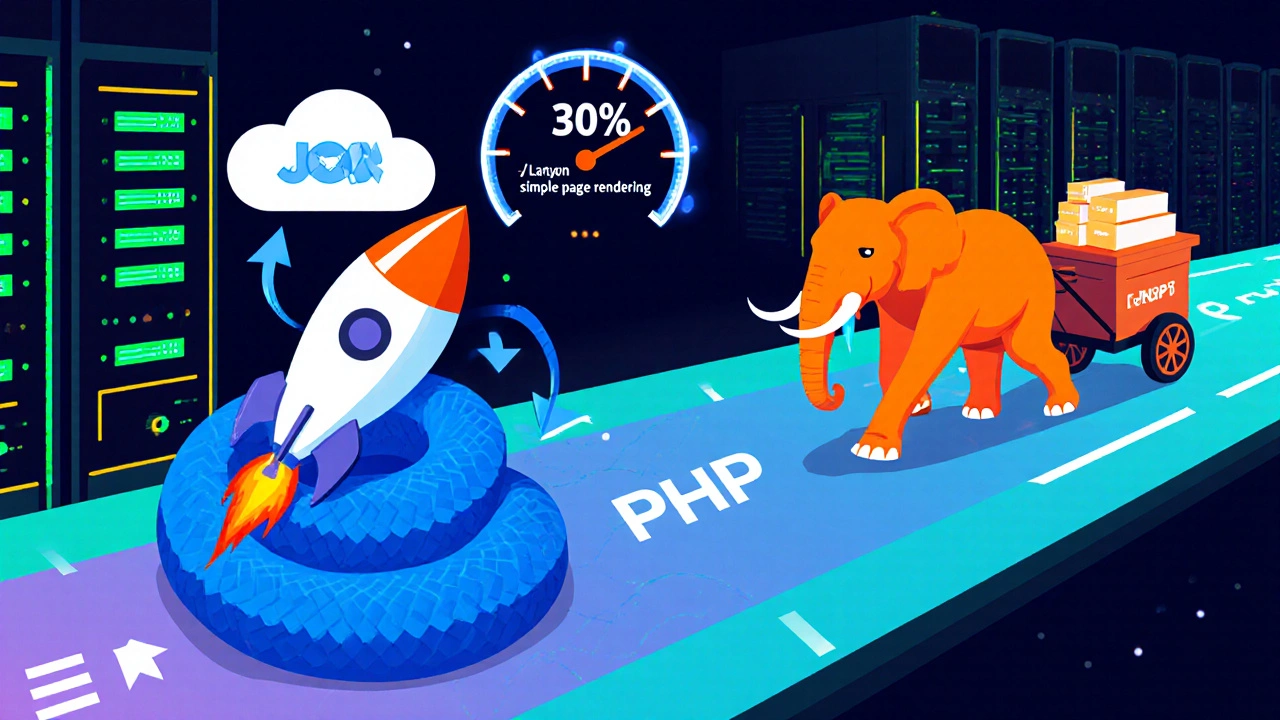Web Development Language Calculator
Select Your Project Profile
When you hear developers argue about the "best" language for web projects, the debate often lands on Python is a high‑level, interpreted language that emphasizes readability and rapid development. It powers everything from scientific research to large‑scale web services. PHP is a server‑side scripting language created specifically for the web. It has been the engine behind millions of sites, especially those built with WordPress. Both have loyal communities, but they thrive in different ecosystems. This article breaks down the key dimensions that matter when you decide which one to adopt for a new project.
Quick Takeaways
- Python shines for data‑intensive, API‑first, and AI‑related projects, while PHP remains the pragmatic choice for traditional content sites.
- Raw request latency favors PHP in simple page rendering, but Python’s async frameworks can close that gap for modern workloads.
- Python’s package index (PyPI) offers >350,000 libraries; PHP’s Composer ecosystem is smaller but mature for web CMS.
- Hiring: Python developers command higher average salaries in the UK, yet PHP talent is easier to find for short‑term contracts.
- Choosing the right language depends more on project goals than on any absolute superiority.
Understanding Python and PHP
Both languages are interpreted, meaning you don’t compile them to machine code before execution. Python was released in 1991, designed for readability (indentation is syntax), and supports multiple programming paradigms: procedural, object‑oriented, and functional. Its standard library includes modules for networking, threading, and data handling.
PHP debuted in 1995 as a set of CGI scripts and quickly evolved into a full‑featured language. Its syntax resembles C, making it approachable for developers with a background in C‑style languages. PHP runs inside a web server (Apache, Nginx) via the FastCGI protocol, which streamlines request handling.
In practice, Python often lives behind a WSGI or ASGI server (Gunicorn, Uvicorn), while PHP runs inside the web server process itself. This architectural difference influences performance, deployment, and scaling strategies.
Performance and Speed
Speed matters when you serve hundreds of requests per second. A simple "Hello World" script in pure PHP typically executes in 2-3 ms, while the same script in Python (using Flask) can take 5-7 ms. The gap narrows when you enable PHP's OPcache, which caches compiled bytecode, and when you use Python’s PyPy or compile critical paths with Cython.
However, raw latency isn’t the whole story. Modern Python frameworks like FastAPI leverage async I/O, allowing a single process to handle thousands of concurrent connections with minimal overhead. In a benchmark for JSON‑API responses, FastAPI on Uvicorn outperformed Laravel (PHP) by roughly 30 % in throughput under identical hardware.
When it comes to CPU‑intensive tasks-image processing, machine learning inference-Python wins because of native bindings to C libraries (NumPy, TensorFlow). PHP can call external binaries but lacks the deep scientific stack that Python enjoys.
Ecosystem and Libraries
The health of a language’s ecosystem often decides how quickly you can deliver features.
- Django and Flask give Python developers ready‑made admin panels, ORM, and routing.
- Laravel and Symfony provide analogous scaffolding for PHP.
- Python’s PyPI hosts over 350,000 packages, ranging from data science (pandas) to authentication (oauthlib).
- PHP’s Composer marketplace focuses on web‑centric libraries: templating (Twig), caching (Redis clients), and CMS integrations.
For database access, both ecosystems support MySQL, PostgreSQL, and SQLite. Python developers often choose SQLAlchemy, while PHP leans on Doctrine. The choice comes down to personal preference and project requirements.
Frameworks and Project Types
When you map language to project archetype, patterns emerge.
| Aspect | Python | PHP |
|---|---|---|
| Core Strength | Data processing, AI, micro‑services | Content sites, e‑commerce, legacy web apps |
| Popular Frameworks | Django, Flask, FastAPI | Laravel, Symfony, CodeIgniter |
| Learning Curve | Gentle; emphasis on readability | Moderate; mixed procedural/OOP syntax |
| Performance (simple page) | ~5‑7 ms (Flask) | ~2‑3 ms (native PHP with OPcache) |
| Community Size (2025) | ≈12 M developers (Stack Overflow survey) | ≈9 M developers |
If your goal is to spin up a REST API quickly, FastAPI lets you declare request schemas with Python type hints, generating OpenAPI docs automatically. PHP’s Laravel offers similar capabilities via Laravel Passport, but the setup requires a few more configuration steps.
For a blog or a WordPress‑powered site, PHP remains the default. WordPress WordPress powers 43 % of all websites; its ecosystem of plugins and themes is unrivaled. Migrating the same site to Django would involve rebuilding much of the CMS layer from scratch.

Hiring, Community, and Salary
In the UK, the average salary for a Python developer (as of Q2 2025) sits around £65,000 per year, whereas a PHP developer averages £55,000. The gap reflects Python’s demand in data science, fintech, and cloud-native startups.
However, PHP talent is more abundant in the freelance market. Platforms like Upwork list roughly 30 % more PHP freelancers than Python for short‑term contracts, which can lower project costs for simple web sites.
Both languages enjoy vibrant communities. Python’s PyCon UK 2025 attracted over 2,500 attendees, while PHPUK 2025 saw 1,800. The size of a community matters for troubleshooting-Stack Overflow answers for Python questions receive a 20 % higher average vote count, indicating more consensus.
When to Choose Python over PHP (and Vice‑versa)
Pick Python if:
- You need heavy data manipulation, machine learning, or scientific computing.
- Your architecture relies on micro‑services, async I/O, or serverless functions.
- You value a single, consistent language across back‑end and automation scripts.
Pick PHP if:
- You are building a content‑driven site, especially with WordPress, Drupal, or Joomla.
- You need rapid deployment on shared hosting where PHP is pre‑installed.
- Your team consists of developers experienced in LAMP stacks.
Bottom Line: Which One Wins?
There is no universal champion. Python offers modern tooling, a massive data ecosystem, and superior async performance, making it the go‑to for new, complex applications. PHP still dominates the CMS market, excels at quick page rendering, and benefits from ubiquitous hosting support. Your decision should weigh project scope, team expertise, and long‑term maintenance rather than chasing a hype headline.
Is Python faster than PHP for web requests?
For a static HTML page, PHP with OPcache is usually a few milliseconds quicker. However, Python’s async frameworks (FastAPI, Starlette) can outperform PHP under high concurrency when the workload involves I/O‑bound operations.

Can I run Python on typical shared hosting?
Most shared hosts only support PHP out of the box. Some providers now offer Python via CGI or Passenger, but you may need a VPS or cloud instance for reliable performance.
Which language has more security updates?
Both languages receive regular patches. PHP’s release cadence is tied to the PHP Group’s schedule; Python follows the Python Software Foundation’s roadmap. In practice, security depends more on the frameworks you choose and how quickly you apply updates.
Is it worth learning both Python and PHP?
If you work on diverse projects-data pipelines on one hand, WordPress sites on the other-knowing both widens your job market. Many concepts (variables, loops, OOP) transfer directly, so the learning curve is modest.
What are the best hosting options for Python apps?
Providers such as Render, Railway, and AWS Elastic Beanstalk offer managed Python runtimes. For container‑first workflows, Docker on DigitalOcean or Kubernetes clusters give you full control over dependencies.





